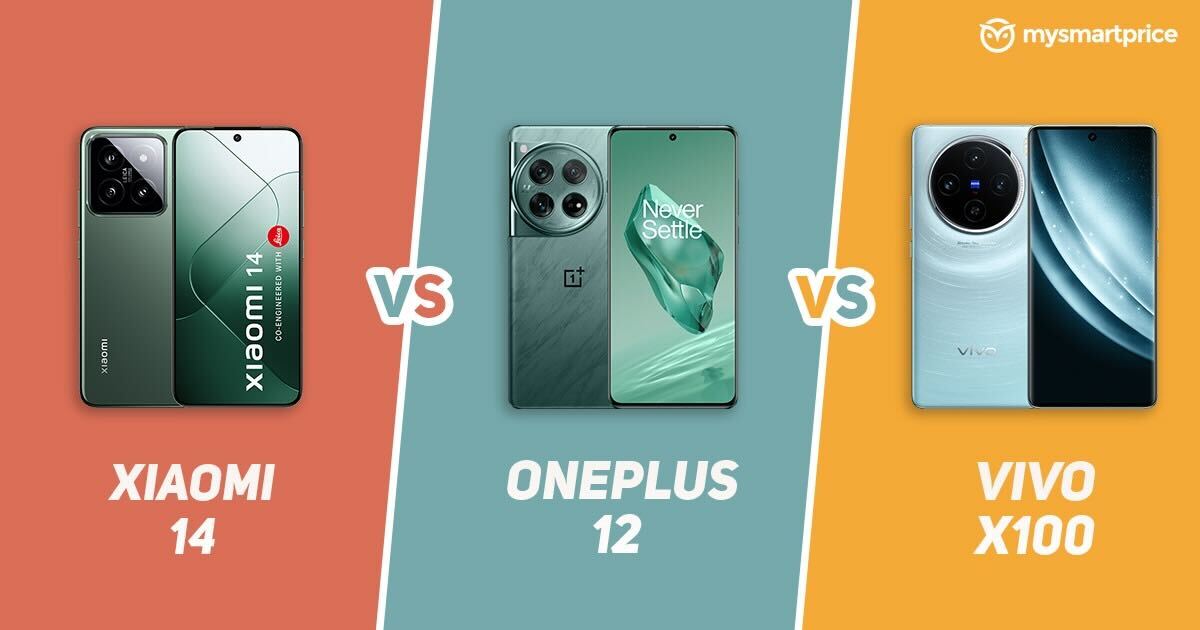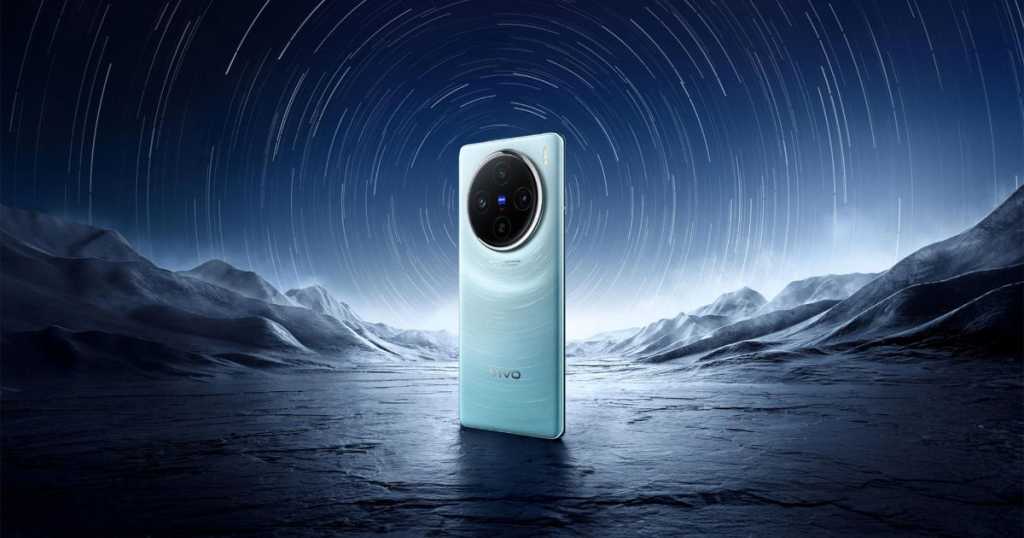- Xiaomi 14 and Vivo X100 come in a single variant with an identical price of Rs 69,999, whereas the OnePlus 12’s base configuration starts at Rs 64,999.
- While Xiaomi and OnePlus offer four Android version upgrades, Vivo will only offer three years of them.

Xiaomi recently unveiled its latest flagship – the Xiaomi 14 in the Indian market. The Xiaomi 14 features a smaller footprint compared to other regular flagships. It is also a camera centric smartphone, developed in collaboration with Leica, that competes against the likes of the Vivo X100 and OnePlus 12.
In this article, we compare the Xiaomi 14 with the OnePlus 12 and Vivo X100, purely on the basis of specifications. Let’s begin.
Xiaomi 14 vs OnePlus 12 vs Vivo X100: Specs at Glance
Here’s a quick glance at the detailed specifications of the three phones:
| Xiaomi 14 | OnePlus 12 | Vivo X100 | |
| Display | 6.36-inch AMOLED 120Hz, 1.5K, 3000nits |
6.78-inch ProXDR 120Hz, Quad HD+, 4500nits |
6.78-inch AMOLED 120Hz, Full HD+, 3000nits |
| Processor | Qualcomm Snapdragon 8 Gen 3 | Qualcomm Snapdragon 8 Gen 3 | MediaTek Dimensity 9300 |
| Software | HyperOS Android 14 |
OxygenOS 14 Android 14 |
FunTouchOS Android 14 |
| Camera | 50MP OIS Camera 50MP Ultrawide Lens 50MP Telephoto Lens |
50MP OIS Camera 48MP Ultrawide Lens 64MP Telephoto Lens |
50MP OIS Camera 50MP Ultrawide Lens 64MP Telephoto Lens |
| Front Camera | 32MP | 32MP | 32MP |
| Battery | 4,610mAh | 5400mAh | 5000mAh |
| Charging | 90W HyperCharge 50W Wireless |
100W SuperVOOC 50W AirVOOC |
120W FlashCharge |
Xiaomi 14 vs OnePlus 12 vs Vivo X100: Price in India
Out of the three contenders, the OnePlus 12’s base variant has the lowest starting price. The Xiaomi 14 and the Vivo X100 have only one variant on sale, and both have identical pricing.
| Smartphone | Configuration | Price |
| Xiaomi 14 | 12GB + 512GB | Rs 69,999 |
|
OnePlus 12
|
12GB + 256GB | Rs 64,999 |
| 16GB + 512GB | Rs 69,999 | |
| Vivo X100 | 12GB + 256GB | Rs 69,999 |
Xiaomi 14 vs OnePlus 12 vs Vivo X100: Design
The OnePlus 12, Xiaomi 14, and Vivo X100 feature premium finish with glass sandwich design and metal frame. However, OnePlus 12 and the Vivo X100 with curved display and curved rear panel. The Xiaomi 14 goes for a rather compact, flattened out design language with flat rails and display.

Moreover, the Vivo X100 and OnePlus 12 feature a circular camera island compared to a squircle camera module on the Xiaomi 14.
Design is a subjective attribute, so we will leave it to you whether you prefer curved panels on the front and back or a completely flat silhouette.
Xiaomi 14 vs OnePlus 12 vs Vivo X100: Display
The Xiaomi 14 flaunts a 6.36-inch LTPO AMOLED display with a 1.5K resolution, 120Hz refresh rate, 3000nits peak brightness, and Corning Gorilla Glass Victus protection. The Vivo X100 offers a 6.78-inch LTPO AMOLED display with Full HD+ resolution, 120Hz refresh rate, and 3000nits peak brightness.
The OnePlus 12 gets a 6.82-inch ProXDR LTPO AMOLED display with Quad HD+ resolution, 120Hz refresh rate, 4500nits peak brightness, and Corning Gorilla Glass Victus 2 protection.
Out of three flagships, the OnePlus 12 has a higher resolution display with highest peak brightness and better protection.
Xiaomi 14 vs OnePlus 12 vs Vivo X100: Performance
The OnePlus 12 and Xiaomi 14 are powered by a Qualcomm Snapdragon 8 Gen 3 with Adreno 750 GPU. Whereas, the Vivo’s flagship sports a MediaTek Dimensity 9300 SoC which comes with an integrated Immortalis G720 GPU. Both these processors are fabricated on TSMC’s 4nm processor.
All three flagships come with LPDDR5X RAM and UFS 4.0 storage. In terms of performance, these flagships should result in similar experience given the hardware they feature.
Xiaomi 14 vs OnePlus 12 vs Vivo X100: Software
- Xiaomi 14 – HyperOS, based on Android 14
- OnePlus 12 – OxygenOS 14, based on Android 14
- Vivo X100 – FunTouchOS 14, based on Android 14
Xiaomi and OnePlus offer four Android version upgrades to their flagship smartphones. Whereas, Vivo promises three Android version upgrades for X-series smartphones. So, the Vivo X100 will get only up to Android 17. Whereas, the OnePlus 12 and Xiaomi 14 will get updates up to Android 18.
Xiaomi 14 vs OnePlus 12 vs Vivo X100: Camera
| Xiaomi 14, tuned by Leica | OnePlus 12, tuned by Hasselblad |
Vivo X100, tuned by Zeiss
|
| 50MP OIS Camera Fusion 900 image sensor 1/1.31-inch sensor size 23mm equivalent focal length f/1.6 aperture |
50MP OIS Camera Sony LYT 808 sensor 1/1.4-inch sensor size 23mm equivalent focal length f/1.6 aperture |
50MP OIS Camera
Sony IMX920 sensor 1/1.49-inch sensor size 23mm equivalent focal length f/1.57 aperture |
| 50MP Telephoto Camera 75mm equivalent focal length f/2.0 aperture 10cm macro photography support OIS |
64MP Periscope Sensor OmniVision OV64B Sensor 1/2-inch sensor size 3x optical zoom 70mm equivalent focal length f/2.6 aperture, OIS |
64MP Telephoto Camera
1/2-inch sensor size 3x Optical Zoom f/2.57 aperture OIS |
| 50MP Ultrawide Sensor 115° field of view 14mm equivalent focal length f/2.2 aperture |
48MP Sony IMX581 Sensor 114° field of view 1/2-inch sensor size 14mm equivalent focal length f/2.2 aperture 3.5 cm macro shot support |
50MP Ultrawide Sensor
1/2.76-inch sensor size 150° field of view f/2.0 aperture |
| 32MP Selfie Camera 89.6° field of view f/2.0 aperture |
32MP Sony IMX615 Sensor 1/2.74-inch sensor size f/2.4 aperture |
32MP Selfie Camera
f/2.0 aperture |
In terms of camera hardware, all three flagship feature the best hardware available in the segment. These handsets offer a versatile camera setup with inclusion of a telephoto lens.
As we noted in our Xiaomi 14 Camera review, the Vivo X100 and Xiaomi 14 have totally different colour science and the shots taken on both stack up against each other well. While, the Vivo X100 appears to have a better low-light performance, the Xiaomi 14 produces more natural looking photos.
Xiaomi 14 vs OnePlus 12 vs Vivo X100: Battery
| Xiaomi 14 | OnePlus 12 | Vivo X100 |
| 4,610mAh | 5400mAh | 5000mAh |
| 90W HyperCharge Charging | 100W SuperVOOC Charging |
120W FlashCharge
|
| 50W Wireless Charging | 50W AirVOOC | – |
The OnePlus 12 packs the biggest battery. Whereas, the Vivo X100 supports 120W fast charging, faster than its competitors. However, it lacks wireless charging which the other two flagships offer. Overall, in battery capacity and charging capabilities, the OnePlus 12 seem to be ahead of the Xiaomi 14.
The Vivo X100, with lack of wireless charging, remains behind the OnePlus 12 and Xiaomi 14 in this department.
Xiaomi 14 vs OnePlus 12 vs Vivo X100: Verdict
The OnePlus 12 and Xiaomi 14, based on specifications, seem to be not missing out any flagship features. But, the OnePlus 12 might appeal to masses because of a bigger, sharper, and stronger display.
Whereas, the Xiaomi 14 might is aimed at those looking for a no-compromise compact flagship smartphone due to which it packs a relatively smaller battery than its competitors. Also, the Xiaomi 14 has a flat edge design which some might find less comfortable compared to the OnePlus 12 and Vivo X100.
The Vivo X100 might have a solid camera performance, thanks to the Zeiss optics, but it does have its shortcomings. The Vivo X100 features a Full HD+ display and does not offer wireless charging. These features are expected from every flagship in 2024 and might be deal breaker for many.



















